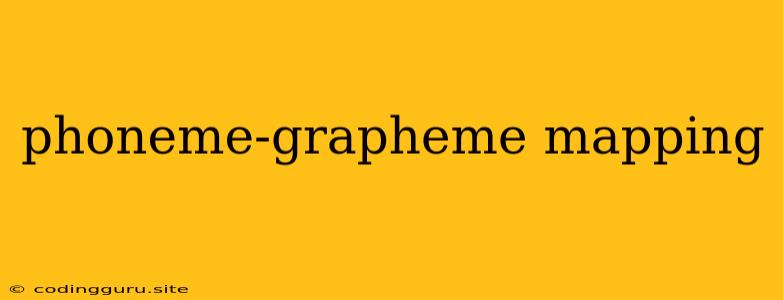Understanding the Bridge Between Sounds and Letters: Phoneme-Grapheme Mapping
The journey from spoken language to written words is not a straightforward path. It involves a complex interplay of sound and symbol, where individual speech sounds, known as phonemes, need to be represented by written symbols, called graphemes. This intricate relationship is known as phoneme-grapheme mapping. It's the foundation of learning to read and write, and understanding it can significantly boost reading skills.
What is Phoneme-Grapheme Mapping?
Imagine the word "cat". It's pronounced with three sounds: /k/, /æ/, and /t/. Each of these sounds is represented by a letter or group of letters: "c", "a", and "t". This mapping between the sounds and their written representations is phoneme-grapheme mapping.
Why is Phoneme-Grapheme Mapping Important?
- Decoding: It allows readers to break down unfamiliar words into their individual sounds and then blend them together to read the word.
- Encoding: Conversely, it helps writers translate the sounds of words into written form, enabling them to spell correctly.
- Reading Fluency: Understanding phoneme-grapheme mapping leads to more efficient and accurate reading, as readers can quickly recognize and pronounce words without having to sound out each letter.
Challenges in Phoneme-Grapheme Mapping
While phoneme-grapheme mapping is a powerful tool, it presents several challenges:
- One-to-Many and Many-to-One Relationships: A single phoneme may be represented by multiple graphemes, such as the "c" sound in "cat", "cell", and "circus". Conversely, a single grapheme may represent multiple phonemes, like the letter "a" in "cat", "father", and "car".
- Silent Letters: Some letters in words have no sound, like the "e" in "make" or the "h" in "honesty".
- Irregular Words: Many words have unpredictable spellings that don't follow consistent phoneme-grapheme mapping rules.
Tips to Improve Phoneme-Grapheme Mapping Skills
- Start with the basics: Teach children the sounds of individual letters and common letter combinations.
- Use visual aids: Charts and flashcards can help visualize the relationship between phonemes and graphemes.
- Practice with games and activities: Engaging in fun activities like word puzzles, rhyming games, and alphabet blocks can reinforce phoneme-grapheme mapping skills.
- Read aloud regularly: Reading aloud provides exposure to different words and their spellings, strengthening the connection between sounds and symbols.
- Focus on phonics: Phonics instruction explicitly teaches phoneme-grapheme mapping rules, making it easier to decode and encode words.
Examples of Phoneme-Grapheme Mapping
- "Cat": The sound /k/ is represented by the grapheme "c", the sound /æ/ by "a", and the sound /t/ by "t".
- "Ship": The sound /ʃ/ is represented by the grapheme "sh", the sound /ɪ/ by "i", and the sound /p/ by "p".
- "Tree": The sound /tr/ is represented by the grapheme "tr", the sound /i/ by "ee", and the sound // by "e".
Conclusion
Phoneme-grapheme mapping is the cornerstone of literacy development. By understanding how sounds are represented by written symbols, children can unlock the world of reading and writing. Helping them develop strong phoneme-grapheme mapping skills will provide them with a solid foundation for lifelong reading success.
